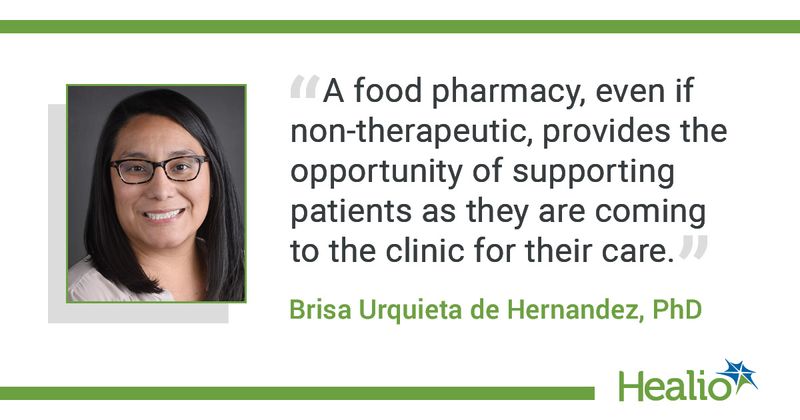Q&A: Primary care intervention offers help for food insecurity
About 11% of U.S. households experienced food insecurity in 2018, and that could reach more than 16% amid the pandemic, data show.
Previous research has indicated that food insecurity is tied to diabetes, hypertension, depression and anxiety.

According to an online survey conducted from April through June and completed by 3,133 U.S. adults, most of them white women, Americans are eating more sweet and salty snacks amid the pandemic and fewer nutritious foods such as fruits, non-starchy vegetables and nuts or seeds.
An in-clinic food pharmacy could help physicians ensure that patients have access to fresh foods. In Annals of Family Medicine, researchers described their experiences with implementing one at a family medicine clinic in North Carolina.
Brisa Urquieta de Hernandez, PhD, one of the article's co-authors who was also a previous director of community health at Atrium Health, where the pilot took place, discussed how others can start their own food pharmacy.
Q: Walk us through how you developed and operated the food pharmacy.
A: The community health division of Atrium Health partnered with a local clinic’s leadership to develop a process for screening patients for food insecurity and referring patients to balanced, healthy, shelf-stable food. A dietician was also engaged in the project to ascertain which food products these patients would get.
At check-in, patients answered 15 questions from the Hunger Vital Signs and the Protocol for Responding to and Assessing a Patient’s Assets, Risks, and Experiences (PRAPARE) tool. One of the three physicians involved in the project reviewed the patient’s responses before entering the exam room. If a patient’s answers indicated they were experiencing food insecurity, the clinician offered a paper referral to the in-clinic food pharmacy for a 2-day emergency supply of food. At the end of the appointment, patients would exchange the paper prescription for a bag of food from the food pharmacy. After the patient received their food, an embedded social worker connected with the patient to understand their and their household needs and make appropriate referrals.
After a 1-month long pilot period, we expanded screening to include all English- and Spanish-speaking patients at yearly and new patient visits. We developed educational materials so that patients understood why their clinician asked them PRAPARE-based questions and encouraged patients to have related conversations with their physicians.
From an administrative side, this process also showed us the importance of using a short, low-reading–level screener translated into multiple languages with an identical and simple electronic medical record data collection tool.
Q: Why might a food pharmacy be a better way to address hunger than other interventions?
A: A food pharmacy, even if nontherapeutic, provides the opportunity of supporting patients as they are coming to the clinic for their care. It also provides a referral to an external food source. Although it may be a new concept to have clinicians ask questions about food insecurity, there is usually already trust built between the patient and the provider.
Q: What barriers might a practice encounter when developing and operating a food pharmacy ? How can these barriers be overcome?
A: Food procurement may be an issue. We were fortunate to partner with a community-based organization that provided us the food. Physicians may also have to establish a workflow to screen patients for food insecurity and help colleagues come on board with the plan. It is also important to find time to follow up with the patients at their next visit to see if they still need support.
Q: What changes might be needed to implement the food pharmacy amid the current pandemic?
A: Clinics will need to pivot in a way that will continue to screen the patients for need and provide them food in a safe and convenient way. For example, have bags pre-packed with the food so that if a patient is screened virtually, he or she can do a curbside pickup of the food outside the clinic’s doors.
Q: Are there any data you can share on the project’s success?
A: This was the initial pilot for the process and we only helped a small number of patients for a short period of time. Therefore, we saw this as a process improvement project rather than a data-driven one. As this process is rolled out to other clinics and across Atrium Health, the plan is to have additional data that show the project’s impact on health outcomes and utilization.
References
- Bin Zarah A, et al. Nutrients. 2020;doi:10.3390/nu12113468.
- Feeding America. “The Impact of the coronavirus on food insecurity.” https://www.feedingamerica.org/sites/default/files/2020-04/Brief_Impact%20of%20Covid%20on%20Food%20Insecurity%204.22%20%28002%29.pdf. Accessed December 10, 2020.
- Hazzard VM, et al. Curr Psychiatry Rep. 2020;doi:10.1007/s11920-020-01200-0.

